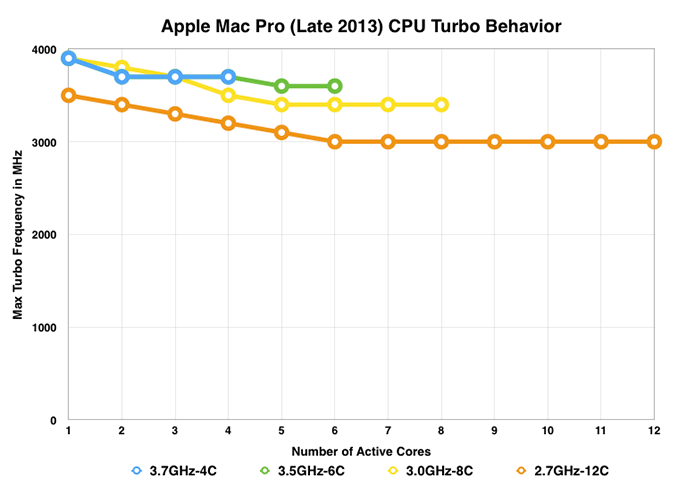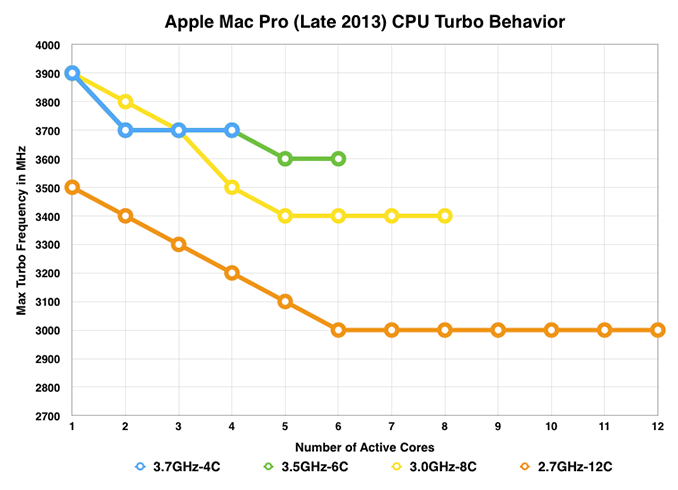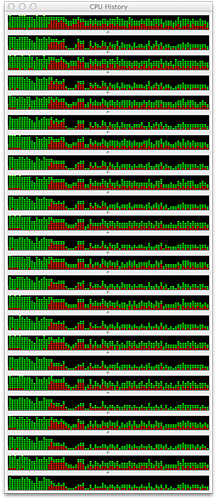The Mac Pro Review (Late 2013)
by Anand Lal Shimpi on December 31, 2013 3:18 PM ESTCPU Choices
Had I gotten around to publishing my rMBP review prior to this one you would’ve seen my praise Apple’s CPU selection abilities as of late. Outfitting all 15-inch rMBPs with Crystalwell was a very wise move on Apple’s part. With the Mac Pro the CPU selection is good, but the decision of what to buy is far more complex than in any other product line.
The Mac Pro not only serves as Apple’s ultra high end Mac, but it’s the only option if your needs exceed that of an iMac or 15-inch MacBook Pro. Literally anyone who needs more performance than Apple offers in an all-in-one or a notebook inevitably is pushed to consider the Mac Pro. With a relatively broad professional audience in mind, Apple offers more CPU options for the Mac Pro than on any other shipping Mac:
| Mac Pro (Late 2013) CPU Options | ||||||
| Intel CPU | Xeon E5-1620 v2 | Xeon E5-1650 v2 | Xeon E5-1680 v2 | Xeon E5-2697 v2 | ||
| Cores / Threads | 4 / 8 | 6 / 12 | 8 / 16 | 12 / 24 | ||
| CPU Base Clock | 3.7GHz | 3.5GHz | 3.0GHz | 2.7GHz | ||
| Max Turbo (1C) | 3.9GHz | 3.9GHz | 3.9GHz | 3.5GHz | ||
| L3 Cache | 10MB | 12MB | 25MB | 30MB | ||
| TDP | 130W | 130W | 130W | 130W | ||
| Intel SRP | $294 | $583 | ? | $2614 | ||
| Apple Upgrade Cost (Base Config) | - | +$500 | +$2000 | +3500 | ||
| Apple Upgrade Cost (High End Config) | - | - | +$1500 | +3000 | ||
There are four CPU options, each with varying core counts. The more cores you get, the lower your base CPU frequency is. In the old days, that would be the end of the discussion - you either choose more cores or more frequency, a tradeoff that is ultimately determined by your workload. Starting with its Nehalem architecture back in 2008, Intel introduced two key technologies that changed the face of multicore on the desktop: power gating and turbo boost. The former is a technology that can almost entirely remove power to a core (both active and leakage) when idle, while the second takes advantage of that freed up thermal budget to drive any active core(s) at higher frequencies. Subsequent implementations of Intel’s Turbo Boost technology have scaled the aggressiveness of this opportunistic frequency scaling, but the basic principle remains the same.
Apple advertises core count and base frequency for all of the Mac Pro CPU options, but to really understand what you’re getting yourself into you need to look at each CPU’s max turbo states vs. number of active cores. Neither Apple nor Intel do a great job of publicly exposing this information, Apple avoids doing so in order to keep things clean/simple, and Intel avoids doing so because perhaps it’s fun? Either way I’ve compiled the data on the four CPU options into the charts below.
I've left base clocks out of the graphs although you can see them noted in the legend at the bottom of each chart.
This first chart has the y-axis starting at 0MHz, but the next one is the more interesting as it starts at 2.7GHz and better illustrates/exaggerates the sort of frequency tradeoff you can expect vs. core count:
The 4, 6 and 8 core CPU options all offer the same peak single core frequency (3.9GHz). This is very important as single threaded performance remains the gate for system responsiveness outside of thread heavy applications. The 12-core CPU sacrifices around 10% of this peak single core performance.
Early on the 8-core CPU holds the advantage over the rest, being able to hit a higher 2-core max turbo. The octa-core’s crossover point happens at 3 active cores, beyond this point the quad and six core CPUs maintain a slight max turbo advantage.
The key takeaway here is that more cores isn’t necessarily better. You need to weigh the needs of your applications against the number of cores in your system. There is no one-size-fits-all answer here. For kicks I looked at the CPU load for a handful of my benchmarks:
![]()
![]()
![]()
Application version seems to have a huge impact on threading. Running our Photoshop benchmark on CS5 vs. CS6 is the difference between loading 2 - 8 cores vs. 3 - 10. The same is true if I compare Final Cut Pro 10.0 vs. 10.1; the latest version from Apple (optimized for the new Mac Pro), makes great use of all 12 cores/24 threads. Workload also has an impact. I took our old Final Cut Pro 10.0 benchmark (1080p) and ran it on 10.1, saw a maximum of 1217% CPU usage. I ran our new 4K benchmark on 10.1 and saw nearly full virtual core utilization (2114% CPU usage).
![]()
Final Cut Pro 10.0 - 1080p Benchmark
![]()
Final Cut Pro 10.1 - 1080p Benchmark
![]()
Final Cut Pro 10.1 - 4K Benchmark
Offline 3D rendering applications typically have the easiest time of chewing up tons of cores, while many others are likely better suited by having fewer cores running at a higher frequency. There's also a serious multitasking benefit if you're the type of person that runs multiple thread heavy workloads in parallel. It's pretty nice having a fairly responsive system while rendering a beefy 4K project in Final Cut Pro. The responsiveness comes courtesy of having a ton of cores in addition to extremely fast IO. That PCIe SSD definitely comes in handy.
If you want the best balance of heavily threaded performance without sacrificing performance in lighter workloads, the 8-core configuration seems to be the best bet. There are definitely bragging rights associated with the 12-core system, but unless you absolutely need a ton of cores you’re likely better suited by the 8-core configuration.













267 Comments
View All Comments
OreoCookie - Thursday, January 2, 2014 - link
You link to a $2000 workstation without graphics cards and just 8 GB RAM. How does that invalidate Anand's claim?DukeN - Thursday, January 2, 2014 - link
I paid $144 for the extra RAM and re-used my old workstation cards.Hardly double the price.
zsquared - Thursday, January 2, 2014 - link
So you are not counting the original cost of the workstation cards but you think you proved you point.And you're telling Anand "Shame"?
Ppietra - Friday, January 3, 2014 - link
memory: 1600 MHz vs 1866 MHzSSD: SATA600 vs PCIe
no thunderbolt
no graphics
clearly the same specs
DukeN - Friday, January 3, 2014 - link
Even with a decent card it's something like $1500 less.This is a fact that isn't acknowledged by Anand, of course because not cozying up to Apple is potentially bad for business.Oh well I'll never be able to convince the Apple fanboys writing or reading here.
Ppietra - Friday, January 3, 2014 - link
the comparison wasn’t about what you can get with the same processor, but how much does it cost to have the same specs, and your comparison doesn’t do that, and you certainly don’t get a machine with the same performance since memory and storage are slower.How do you get it for $1500 less when your machine base price is 1000$ less. If you add 2 decent graphic cards (with comparable performance) and the extra memory to match you quickly get at the Mac Pro price and still you would probably get worse performance!
Liquidmark - Friday, January 3, 2014 - link
Where's your graphics card?8GB of ram?
SATA SSD?
Here's what I got so far from lenovo's site...
Intel Xeon E5-1620 v2 Processor (10MB Cache, 3.70GHz)
Windows 8 Pro 64 Downgrade Windows 7 Professional 64 English
Tower 5x6 Mechanical Shell with low inrush current power supply
Windows 8 Pro 64 RDVD English
16GB ECC 2Rx4 PC3 1600MHz RDIMM
NVIDIA® Quadro K2000D (2GB Dual link DVI+DVI, Mini DP) - (For Windows 7 ME8.0)
NVIDIA® Quadro K2000D (2GB Dual link DVI+DVI, Mini DP) - (For Windows 7 ME8.0)
DVI to VGA Dongle
Integrated Audio
Intel SATA HDD support (1-3 HDDs)
Internal RAID - Not Enabled
2.5" 256GB SATA SolidState Drive
29-in-1 Media Card Reader - (For Windows 7 ME8.0)
DVD Burner/CD-RW Rambo Drive (SATA) - Win7 ME8.0
Integrated Ethernet
USB Preferred Pro FullSize Win8 US Euro English 103P
Lenovo USB Optical Wheel Mouse
LineCord - US
Publication - English
$4,128.00
Mac Pro with 16 gb instead of 12 for ram...
$3,099.00
Come on man...
Liquidmark - Friday, January 3, 2014 - link
Oop, I forgot the Applecare!Ok, Mac Pro= $3,348.00
Lenovo Lenovo S30= $4,128.00
RollingCamel - Thursday, January 2, 2014 - link
No engineering software performance review?wheelhot - Saturday, January 4, 2014 - link
I wonder why as well, I don't see anything wrong to do some windows engineering software tests